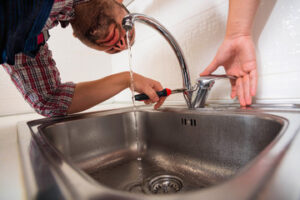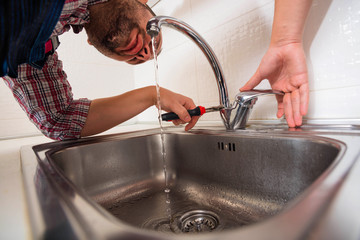Leaking faucets are a nuisance that no homeowner wants. Fortunately, there are steps you can take to repair a leaky faucet. First, shut off the water at the main supply. This will help you avoid a costly call to a plumber. Next, remove the faucet handle and its screw.

If you have a dripping sink, shower, or tub faucet, there are several things that you can do to fix the problem. These include cleaning the parts that are causing the leak, changing out the washer or O-ring, and replacing the valve seat. However, if you want some professional help, you can contact a professional plumber.
A dripping faucet can be very annoying, especially since it wastes water and increases your utility bills. It can also leave rust stains on your countertops and cabinets.
One of the best ways to fix a leaking faucet is to replace the washer or O-ring. You can usually find these parts at your local hardware store.
Before starting a repair, you should turn off the water supply to the faucet, either at a shutoff valve under the fixture or at the main shutoff valve located in your basement or crawlspace. This will ensure that there is no pressure buildup in the pipes before you start working on it.
Next, take the faucet stem assembly apart. This is the part that is screwed into the valve seat and the handle body. On older faucets, this may be concealed under a decorative cap on the handle. To remove it, grip the cap with pliers and unscrew it.
Then, remove the handle body from the faucet stem assembly and inspect it for signs of damage or wear. If the handle is bent or swollen, you might need to replace the washer or O-ring.
If the handle is in good condition, it will likely not need to be replaced. If the handle is loose, however, it could be a sign that there is a leak in the handle itself. You might want to get a plumber to check it out.
Now, remove the old stem washer and screw, then install a new one in its place (smooth side out, any embossed writing on it affixed to the stem base). If the washer is secured with a screw, insert it into the hole and tighten it with a screwdriver.
The round ridge in the bottom of this washer is the seat against which it presses to close the valve. If the ridge is cracked or slightly rough, this will allow water to leak out when the washer is compressed. A damaged valve seat should be replaced or refaced, but this isn’t something you should do unless you are a plumbing expert and have some tools to do it yourself.
Ball faucets are a common type of single-handle bathroom and kitchen faucet. They have a ball-shaped cap and a rubber washer that sits on the end of the spout, preventing water from leaking through the spout. If the rubber washer wears out, the faucet can leak, and you may need to replace it.
Leaks are often caused by worn-out seals and O-rings, but they can also be a result of corrosion or wear in the valve seat. If your ball-type faucet is leaking, take it apart and inspect the parts for wear or damage.
The first step is to remove the decorative caps on each handle. These will usually have an “H” or a “C” on them. Once the caps are off, look for an Allen screw hidden underneath. Use a flathead screwdriver to loosen the screw, and then remove it.
If the Allen screw is too tight, turn it counter-clockwise to loosen it enough for you to access it. If it is too loose, you can try to unscrew it with a spanner tool found in most repair kits.
You can also use a flathead screwdriver to remove the ball. You can then clean the ball and seat with a soft cloth. Alternatively, you can buy replacement seats and springs from a plumbing supply store or a hardware store.
Once you have the new parts, it’s time to reassemble the faucet. This process can be a little difficult on a ball faucet because there are many parts that need to fit properly. You can make things easier by taking photos or notes of each part as you go along.
Once the parts are in place, you’ll need to tighten the retaining nuts. These nuts can be located on the body of the faucet or in the handle itself. Depending on the design of the faucet, they may have exterior threads that tighten onto the main body or interior threads that lock into the handle. The retaining nuts can be tightened with a box end wrench or crescent wrench.
Ceramic disc faucets are one of the latest technologies in modern faucet design. They combine hot and cold water in a mixing chamber with two ceramic discs that raise and lower to control the volume of water flow. The low-friction design allows the handle to turn on and off easily, making them more user-friendly for people with disabilities or other conditions that restrict grip.
They are also very durable, making them a good investment for homeowners who want to avoid the frequent need for repairs. They tend to cost more than traditional faucets, but the premium price is typically well worth it over the long run.
If you have a leaking ceramic disc faucet, it is essential to shut off the water supply and inspect the faucet body. You may need to replace seals or a damaged cartridge if the leak is coming from these areas.
First, remove the escutcheon cap and the decorative screw. Then, unscrew the cylinder mounting screws and lift off the cylinder. You can clean the cylinder with distilled white vinegar and a soft scouring pad, or you can replace it with new neoprene seals.
Once you have a clean and dry cylinder, you can reinstall it to your faucet. Depending on the type of ceramic disc faucet you have, the order of parts to reassemble should be neoprene seals, ceramic-disk cylinder, cylinder mounting screws, escutcheon cap, handle, and decorative screws.
It is a good idea to use a hose to test the faucet after you have repaired it, as this will help eliminate air that could potentially leak into the system. You should also check the cylinder openings for any debris that might have accumulated during the repair process.
If you are unable to fix the leaking ceramic disc faucet, you might need to replace the cartridge. Luckily, this is a fairly simple task, as many faucet manufacturers produce cartridge replacements in standard sizes. You can buy them at any hardware or plumbing supply store, and they usually come with a plastic spanner cap that helps to twist and loosen the cartridge to make it easier to remove.
Single-handle faucets are usually easier to repair than other types of faucets because there is only one part that needs to be replaced. However, if a dripping or leaky faucet is causing damage to your sink or countertops, you may want to call a plumber instead of doing the work yourself.
To begin the repair process, you need to determine what is causing your faucet to drip. Sometimes it is the cartridge or the O-ring, which are simple parts that can be purchased from hardware stores. Other times, you will need to replace the entire faucet.
Once you have a clear understanding of what is wrong with your faucet, you need to get the correct tools and parts to fix it. These include a crescent wrench, needle-nose pliers, and replacement parts for your particular faucet model.
First, take the handle off of your faucet by removing the decorative cover and loosening the setscrew with an Allen wrench. It is often located under the cover on the back of the handle or beneath a small cap on the front that you can pry off with a small flathead screwdriver.
Now that you have the handle off, you can get to the retaining nut for your cartridge. Depending on the type of cartridge, you might need to remove a decorative collar or other parts before reaching it. If the nut is a large hex-shaped nut, use channel-type pliers or an adjustable wrench to turn it counter-clockwise and remove it.
Next, pull the cartridge out of the faucet body. You can do this by simply pulling it straight up or by placing it on a rag and turning the nut clockwise until you have enough room to pull it out.
Then, insert the new cartridge into your faucet body, aligning the tabs or pegs on the cartridge with the notches or holes in the faucet body. You will also need to replace the retainer nut or clip it onto the cartridge, as needed.

